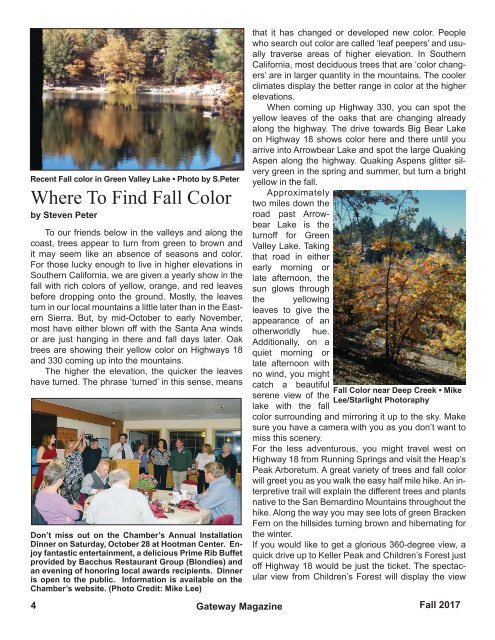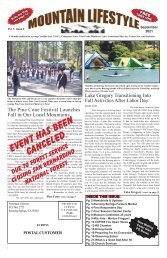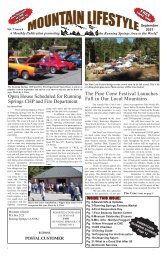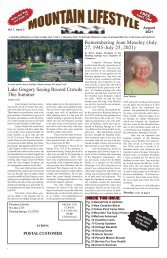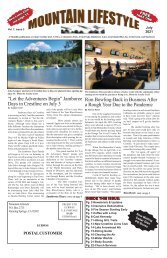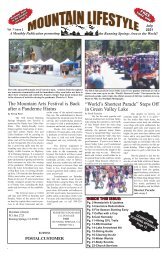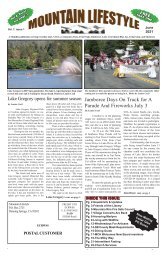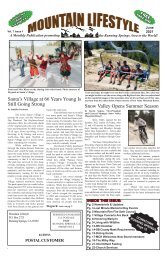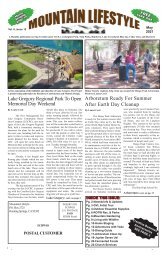Create successful ePaper yourself
Turn your PDF publications into a flip-book with our unique Google optimized e-Paper software.
Recent <strong>Fall</strong> color in Green Valley Lake • Photo by S.Peter<br />
Where To Find <strong>Fall</strong> Color<br />
by Steven Peter<br />
To our friends below in the valleys and along the<br />
coast, trees appear to turn from green to brown and<br />
it may seem like an absence of seasons and color.<br />
For those lucky enough to live in higher elevations in<br />
Southern California, we are given a yearly show in the<br />
fall with rich colors of yellow, orange, and red leaves<br />
before dropping onto the ground. Mostly, the leaves<br />
turn in our local mountains a little later than in the Eastern<br />
Sierra. But, by mid-October to early November,<br />
most have either blown off with the Santa Ana winds<br />
or are just hanging in there and fall days later. Oak<br />
trees are showing their yellow color on Highways 18<br />
and 330 coming up into the mountains.<br />
The higher the elevation, the quicker the leaves<br />
have turned. The phrase ‘turned’ in this sense, means<br />
Don’t miss out on the Chamber’s Annual Installation<br />
Dinner on Saturday, October 28 at Hootman Center. Enjoy<br />
fantastic entertainment, a delicious Prime Rib Buffet<br />
provided by Bacchus Restaurant Group (Blondies) and<br />
an evening of honoring local awards recipients. Dinner<br />
is open to the public. Information is available on the<br />
Chamber’s website. (Photo Credit: Mike Lee)<br />
that it has changed or developed new color. People<br />
who search out color are called ‘leaf peepers’ and usually<br />
traverse areas of higher elevation. In Southern<br />
California, most deciduous trees that are ‘color changers’<br />
are in larger quantity in the mountains. The cooler<br />
climates display the better range in color at the higher<br />
elevations.<br />
When coming up Highway 330, you can spot the<br />
yellow leaves of the oaks that are changing already<br />
along the highway. The drive towards Big Bear Lake<br />
on Highway 18 shows color here and there until you<br />
arrive into Arrowbear Lake and spot the large Quaking<br />
Aspen along the highway. Quaking Aspens glitter silvery<br />
green in the spring and summer, but turn a bright<br />
yellow in the fall.<br />
Approximately<br />
two miles down the<br />
road past Arrowbear<br />
Lake is the<br />
turnoff for Green<br />
Valley Lake. Taking<br />
that road in either<br />
early morning or<br />
late afternoon, the<br />
sun glows through<br />
the yellowing<br />
leaves to give the<br />
appearance of an<br />
otherworldly hue.<br />
Additionally, on a<br />
quiet morning or<br />
late afternoon with<br />
no wind, you might<br />
catch a beautiful<br />
serene view of the<br />
lake with the fall<br />
<strong>Fall</strong> Color near Deep Creek • Mike<br />
Lee/Starlight Photoraphy<br />
color surrounding and mirroring it up to the sky. Make<br />
sure you have a camera with you as you don’t want to<br />
miss this scenery.<br />
For the less adventurous, you might travel west on<br />
Highway 18 from Running Springs and visit the Heap’s<br />
Peak Arboretum. A great variety of trees and fall color<br />
will greet you as you walk the easy half mile hike. An interpretive<br />
trail will explain the different trees and plants<br />
native to the San Bernardino Mountains throughout the<br />
hike. Along the way you may see lots of green Bracken<br />
Fern on the hillsides turning brown and hibernating for<br />
the winter.<br />
If you would like to get a glorious 360-degree view, a<br />
quick drive up to Keller Peak and Children’s Forest just<br />
off Highway 18 would be just the ticket. The spectacular<br />
view from Children’s Forest will display the view<br />
4 <strong>Fall</strong> <strong>2017</strong><br />
<strong>Gateway</strong> <strong>Magazine</strong><br />
RUNNING SPRINGS<br />
sity of 885.1 per square mile, of which 1,419 (73.0%)<br />
Demographics<br />
The 2010 United States Census reported that Running<br />
Springs had a population of 4,862. The population<br />
density was 1,154.0 people per square mile. The racial<br />
makeup of Running Springs was 4,325 (89.0%) White<br />
(79.8% Non-Hispanic White), 23 (0.5%) African American,<br />
47 (1.0%) Native American, 50 (1.0%) Asian, 6<br />
(0.1%) Pacific Islander, 146 (3.0%) from other races,<br />
and 265 (5.5%) from two or more races. Hispanic or<br />
Latino of any race were 695 persons (14.3%).<br />
The Census reported that 4,862 people (100% of<br />
the population) lived in households, 0 (0%) lived in<br />
non-institutionalized group quarters, and 0 (0%) were<br />
institutionalized.<br />
There were 1,944 households, out of which 611<br />
(31.4%) had children under the age of 18 living in<br />
them, 1,026 (52.8%) were opposite-sex married couples<br />
living together, 171 (8.8%) had a female householder<br />
with no husband present, 106 (5.5%) had a<br />
male householder with no wife present. There were<br />
114 (5.9%) unmarried opposite-sex partnerships, and<br />
38 (2.0%) same-sex married couples or partnerships.<br />
477 households (24.5%) were made up of individuals<br />
and 140 (7.2%) had someone living alone who was 65<br />
years of age or older. The average household size was<br />
2.50. There were 1,303 families (67.0% of all households);<br />
the average family size was 2.99.<br />
The population was spread out with 1,119 people<br />
(23.0%) under the age of 18, 375 people (7.7%) aged<br />
18 to 24, 1,157 people (23.8%) aged 25 to 44, 1,672<br />
people (34.4%) aged 45 to 64, and 539 people (11.1%)<br />
who were 65 years of age or older. The median age<br />
was 41.7 years. For every 100 females there were<br />
105.5 males. For every 100 females age 18 and over,<br />
there were 103.4 males.<br />
There were 3,729 housing units at an average den-<br />
were owner-occupied, and 525 (27.0%) were occupied<br />
by renters. The homeowner vacancy rate was<br />
5.3%; the rental vacancy rate was 12.6%. 3,450 people<br />
(71.0% of the population) lived in owner-occupied<br />
housing units and 1,412 people (29.0%) lived in rental<br />
housing units.<br />
According to the 2010 United States Census, Running<br />
Springs had a median household income of<br />
$59,111.<br />
<strong>Gateway</strong> <strong>Magazine</strong><br />
<strong>Fall</strong> <strong>2017</strong> 5


